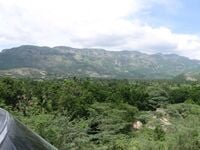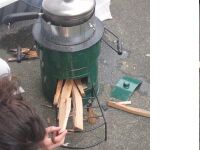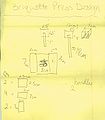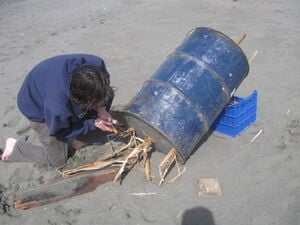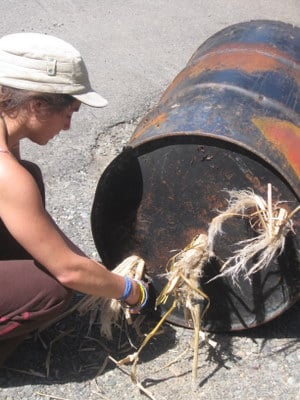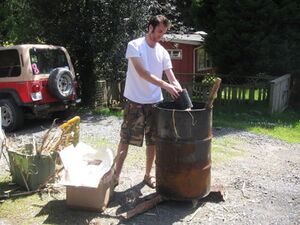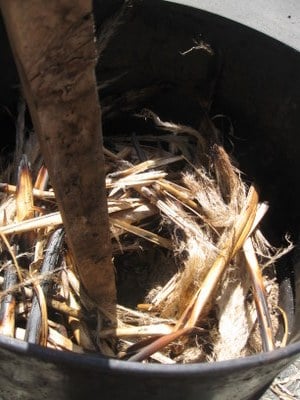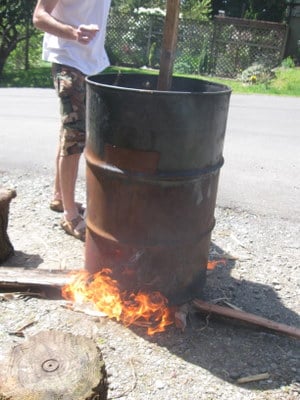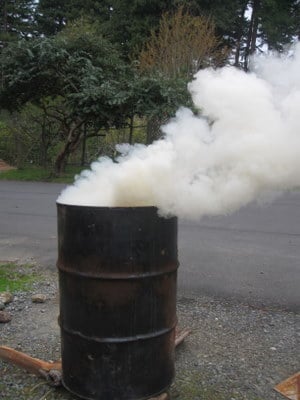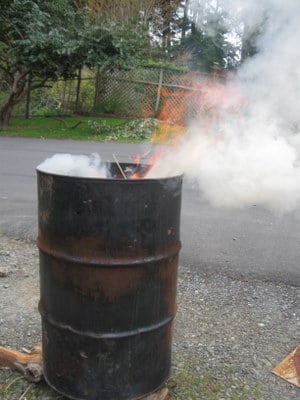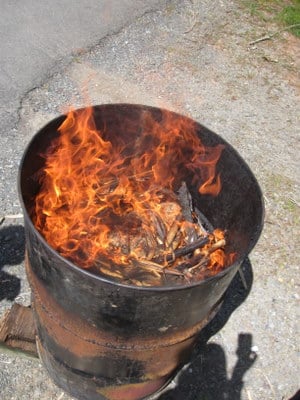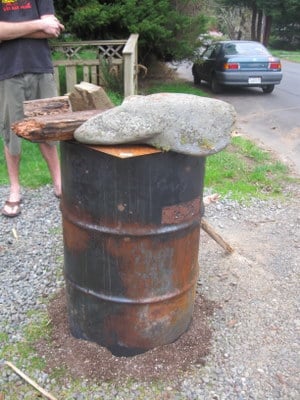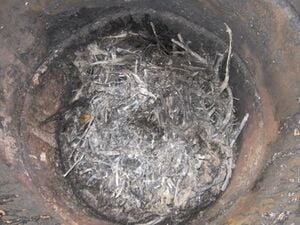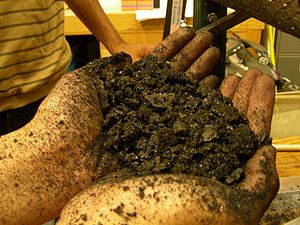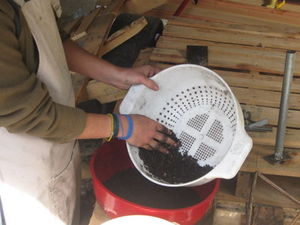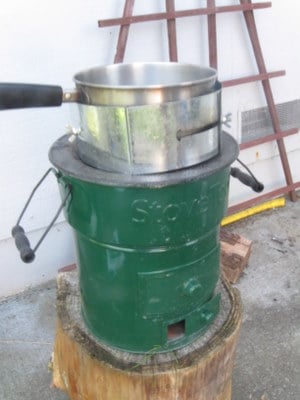
Mitch Girard and Hoon Peerless will be working in conjunction to research, design, test, and report on the use of biomass waste charcoal briquettes for rocket stoves in ENGR305 at Cal Poly Humboldt, during Spring Semester 2010. We will be seeking knowledge of biomass material type, binding agents, and charcoal press mechanisms.
Outside resources will likely include, faculty of HSU, recent HSU engineering graduates, Aprovecho Research Center, and affiliates that are currently located in Haiti working on appropriate technology for local populations. The goal of the project is to produce biomass charcoal briquettes and a press, and to test the briquettes using the Stovetec rocketstove.
Problem statement[edit | edit source]
-
Deforestation in Haiti
-
Deforestation in Haiti
-
Example cookstove
Wood, charcoal, coal and other biomass are used by about 2.4 billion people worldwide as their primary cooking fuel.[1] In 'developing' countries, these fuels are often burned in open fires or poorly functioning stoves.[2] Several factors from these cooking processes have been shown to be damaging to human health, especially attributing to respiratory related illness. Indoor smoke given off by these fuels contains constituents including small soot or dust particles that are able to penetrate deep into the lungs. Every year, indoor air pollution is responsible for the death of 1.6 million people - that's one death every 20 seconds.[3] Women and children being the ones most involved or exposed to this environment are worst affected.[1]
Charcoal production has been associated with environmental issues such as deforestation which further increases other environmental and social vulnerabilities. The trees that grow most slowly; hardwood trees make the highest quality charcoal, furthering the impact.[1] Wood or wood charcoal is the primary cooking fuel in Haiti, and this dependence has contributed to only 2% of Haiti's forests remaining.[4] In places like Haiti, the limited availability of wood means that finding gathering fuel consumes time and energy, causes more severe weather, increases vulnerability, reducing capacity, costs money and further stresses an already depleted resource. In some places such as in Mali, due to changes in the energy and economic sectors a pronounced shift from fuel wood to charcoal is happening which is raising concerns for the local resources[5]
There are alternatives to producing charcoal from wood; it can be produced from any appropriate agricultural waste. Several different crops can be used with locality availability dictating what is used. In Haiti dried sugar cane or bagasse is used, as it is a readily available by-product of sugar production. The charcoal briquettes are produced by combing the carbonized biomass with a binder also of local appropriateness, in Haiti cassava flour is used. The mixture is then made into briquettes using some sort of press and left to dry.
The StoveTec rocket stove designed at the Aprovecho Research Center are optimized to provide low cost, low emission and fuel –efficient solutions. They increase heat transfer and combustion efficiency for cleaner and more efficient cooking.[6] The stove can burn wood, charcoal or other biomass. The rocket stoves in use in Haiti now are cutting down the amount of charcoal needed for cooking by as much as 70%.[7]
Our objectives are to develop an efficient and production type of briquetting machine made from locally available materials; test different agricultural waste materials; test the performance of the machine in terms of compaction ratio, evaluate the firmness of the briquettes, and calculate their heat value.[8]
Criteria[edit | edit source]
The criteria will help us best judge our project outcome and priorities for the project.
| Criteria | Definition | Constraints | Weight (0-10 highest) |
|---|---|---|---|
| Low/clean emission | This means reducing emissions, creating a clean burning fuel | 10 | |
| Use of local materials | biomass and press materials should be locally derived | The crops (sugarcane, rice, bamboo) of interest for research are not local to our area. However we are using the local invasive pampas grass. | 10 |
| Cultural appropriateness | The use and design of the briquette press and the biomass material, as well as the process of making charcoal should be appropriate to the local culture. | This project is not appropriate to our local culture and climate | 10 |
| Cost | should be affordable | costs of metal labor, biomass, and materials vary | 7 |
| Briquette efficiency | Briquettes should be heat efficiency, with an appropriate briquette to meal ratio | 9 | |
| Briquette durability | Briquettes should stay binded and consistent | Local climate impacting moisture content affecting durability | 8 |
| Press Durability | The briquette press should sustain its design and hold up to press large loads of briquettes | We will not make as much briquettes or have enough time as needed to test real durability. | 7 |
Literature review[edit | edit source]
This is a review of the available literature pertinent to the Rocket stove biomass charcoal project.
Theory of Stove design[edit | edit source]
The Main technical objectives of stove design are to:
- Maximize the efficiency of the fuel combustion process
- Transfer heat from the source to the food at the required rate as efficiently as possible.[9]

Intro to Charcoal Stoves[edit | edit source]
- Even though traditional charcoal stoves are usually more efficient than traditional woodstoves, 60% to 80% of the energy is lost in the process of converting wood to charcoal. Because of lower transport, handling and storage costs per unit of energy, charcoal has many adavantages economically over wood. It burns cleaner producing less smoke and demands less tending to maintain a constant heat output.[9]
- Design guidelines for charcoal stoves differ from those for wood stoves due to:
- the fuel contains more energy per unit of volume and can be packed tightly
- most of the heat transfer is from the charcoal bed rather than from moving flames
- the fuel only needs to be tended every half hour, or longer, rather than every 3-10 minutes with wood stoves
- there is usually no or little smoke from a charcoal fire, so chimneys are not necessary[9]
- Charcoal stoves are lightweight, portable, have one fire per pot, and have no chimney. Design improvements to increase cooking performance center on changes to the stove body surrounding the firebox.[9]
Basic design components[9]
- Primary air entrance
- Grate
- Combustion chamber
- Pot Seat
- Pot Shields
- Stove Body
Stove Testing[9]
- Tests to reveal quantitative and qualitative information about concerning the performance of the stove and /or fuel will embrace the following:
- The amount of fuel required to cook a given amount of food
- The thermal efficiency (or Percentage Heat Utilized -PHU) for different rates of boiling water
- The range of power output (also expressed as 'turn down ratio')
- The ease of operation
- Level of pollution
- Maintenance requirements
- These characteristics will be tested through several water boiling and cooking tests
Agricultural Waste Materials[edit | edit source]
When measured in terms of their weight, energy content or nutrient value, agricultural wastes/residues are a vital component in the rural agricultural system. They are a major resource, although patterns of production and use differ widely among different countries and agricultural systems.[10]Possible agricultural waste materials to make charcoal with:
- Sugarcane bagasse
- Corn cob
- Sawdust
- Coffee husk
- Coconut shell
- Bamboo
- Groundnut shell
- Rice husk
Access and Availability[edit | edit source]
- Availability of Agr.wastes depends on production as well as social and economic factors
- Access is influenced by land ownership and status
- Seasonality of supply is an important[11]
- Consideration for some storage facilities must be given in order to allow a year-round operation/supply[10]
Environmental Concerns[edit | edit source]
- The two main concerns with charcoal production are deforestation and intensive cultivation of mono-cultures and environmental issues in connection with carbonization (I.e. smoke, heat and byproducts)[8]
Charcoal Briquetting[edit | edit source]
Four major steps:[11]
- Preparation of charcoal fines
- Mixing the charcoal fines with a binder
- Briquetting of the mixture
- Drying of the briquettes
Binders[edit | edit source]
- Binders are needed when the pressure produced by the compacting equipment is too low for 'self-bonding' or when materials are compacted that do not self-bond such as straw, rice, husk and charcoal. Commonly used binding agents include starches from corn, wheat, cassava (manioc), sugar cane molasses, tars, pitch, resins, glues, fibre, fish waste and certain plants like algae[11]
- The effect of adding a bonding agent is to enhance cohesion and reduce pressure requirements. Binders hold components by both mechanical and chemical adhesion, and occurs when the binder molecules adhere to specific points in the molecular structure of the adherent[8]
- Cassava, a tropical root crop often used as a binding agent, is quite robust and can be grown in infertile soil. It also has unique properties such as its high viscosity and reisitance to freezing[8]
Data[edit | edit source]
Useful data to gather
- Compaction ratio
- Firmness of the Briquettes
- Utilized Heat[8]
- Burn time
Time line[edit | edit source]
Throughout the Spring Semester of 2010, group members researched, designed, tested, and reported on this project. Below are the completed tasks with the representative dates completed. Weather conditions proved difficult during times, thus explaining the density of work at particular dates.
- Week of March 7th- Receive order of sugarcane bio-waste, purchase binder, construct burning chamber from 55 gallon drum.
- Week of March 7th- Harvest locally invasive Pampas Grass from the community.
- Weekend of March 13th- First runs of charcoal manufacturing.
- March 25th- Design and manufacture charcoal press with scrap metal and some welding.
- March 15th-31st- More runs of charcoal production with various materials, binders, and press techniques.
- Beginning of April- Comparative data analysis from previous runs of charcoal production to determine best technique/materials.
- End of April- Results of project discussed, and information provided via appropedia.
Budget[edit | edit source]
| Quantity | Material | Source | Cost ($) | Total ($) |
|---|---|---|---|---|
| 1 | Rocketstove | Stove tech | $40.00 | $40.00 |
| 1 lb | binder | Coop | $.99 | $.99 |
| 27 lbs | Agriculture waste | various | donated/shipping cost | $27.00 |
| 15 lbs | metal | metal salvage shop | $10.00 | $10.00 |
| 1 | 55g oil drum | metal salvage shop | $12.00 | $12.00 |
| 2 hrs | labor for briquette press | Jordan King | Donated | $20.00 |
| 10 | plastic trashbags | Grocery Store | $5.00 | $5.00 |
| 4 | bowl/mixing supplies | Personal Possession | Free | $5 |
| 1 | digital thermometer | Personal Possession | Already had (but only needed for testing purposes) | $30 |
| Total Cost | $150 Total worth | |||
| Total Cost | $95 Total Spent | |||
Briquette Press Design[edit | edit source]
- Briquette Press Design
-
-
Action of the press
-
Prototype for press
-
-
Finished press parts
The Process[edit | edit source]
Preparation (varies)[edit | edit source]
-
Kiln/vessel with lid for carbonizing, we used a 55 gallon drum (being cleaned in this image)
-
Gathering Biomass
-
We used the local invasive Pampas grass as well as a some cattail
Steps[edit | edit source]
Making briquettes[edit | edit source]
Mix binder. We used wheat flour mixed with water. The binder should be a thick, sticky porridge-like consistency.
Combine binder & charcoal. The less the binder is needed, the more ideal. 10%-90% ratio would be ideal and 50%-50% would be too much.
Make briquette using the press.
-
placing in press
-
pressing
-
removing from press
-
removed briquette
Dry briquettes.
-
drying
-
more drying
Results[edit | edit source]
Briquette Process[edit | edit source]
| Batch Number | Amount of Ash | Amount of Binder | Briquette Dimensions (cm3) (length x width x height) | Density (gram/cubic centimeter) |
|---|---|---|---|---|
| One | One cup | 4 tablespoons | 4.5x7x1.9 | 0.42439 gram / cubic centimeter |
| One | One cup | 2-3 tablespoons | 4.5x7x2.1 | 0.24943 gram / cubic centimeter |
| One | One cup | 3 tablespoons | 4.5x7x3 | 0.59788 gram / cubic centimeter |
| One | Two cups | 3 tablespoons | 4.5x7x2.5 & 4.5x7x2.4 | 0.44063 gram / cubic centimeter & 0.38888 gram / cubic centimeter |
| One | One cup | 2 tablespoons | 4.5x7x2.0 | 0.31111 gram / cubic centimeter |
| Two | 3 cups | 9 tablespoons | 4.5x7x2.7 & 4.5x7x2.0 | 0.42093 gram / cubic centimeter & 0.39047 gram / cubic centimeter |
| Two | 3 cups | 6 tablespoons | 4.5x7x2.6 & 4.5x7x2.3 & 4.5x7x1.6 | 0.42735 gram / cubic centimeter & 0.42788 gram / cubic centimeter & 0.36309 gram / cubic centimeter |
| Two | 1 cup | 2 tablespoons | 4.5x7x1.8 | 0.22575 gram / cubic centimeter |
| Two | 1 cup | 3 tablespoons | 4.5x7x2.0 | 0.46031 gram / cubic centimeter |
Stove Tests[edit | edit source]
| Trial # | # of Briquettes Used | Range in Temp. | Burn Time | Comments |
|---|---|---|---|---|
| One | One briquette | 65of-85of | 40 minutes | One briquette is not enough to bring water to boil, failed first run. |
| Two | Four briquettes | 75of-180of | 1 hour 10 minutes | Started with two briquettes and brought water to 105of, added two more briquettes and brought the temperature up to 180of. Nearly boiling conditions. |
| Three | Five briquettes | 75of-210of | 45 minutes | Started the burn with three briquettes and broke each in half to increase surface area which brought temp to 165of. At 23 minutes added two more briquettes in similar fashion to achieve boiling of the water. Most appropriate for cooking a meal with a short cooking time |
| Four | Six briquettes | 75of-220of | 55 minutes | Started the burn with three briquettes and got temp to boiling point very fast (<10 minutes), then added three more briquettes quite early. Brought the water to a vigorous boil and then allowed boil to occur. Since we added the briquettes in a condensed amount of time, the total burn time was shorter but the maximum temp was reached. Most appropriate for cooking a meal that has a long cooking time. |
| Five | Five briquettes | 75of-220of | 20 minutes | Added all briquettes at the beginning and like the other runs, broke them all in half. Quickest time to boil (8.5 minutes) out of all the runs done. The boil was sustained for 18 minutes then died down to a simmer for another 15 minutes. Most appropriate for flash boiling water to purify. |
Testing[edit | edit source]
Intended Use[edit | edit source]
This process and press is intended for small families and/or communities. There are presses and grinders that have been made for higher production rates and industrial uses. For best maintenance of the press, it is ideal to clean it out when each session is finished. There can be a main entity who produces the charcoal and one who produces briquettes as well. The briquettes can be for personal use or made to be sold. Because local knowledge and processes of producing the charcoal and the appearance(minus the shape) are altered little, the briquettes have a better chance of being adopted in place of regular wood charcoal.
Conclusion[edit | edit source]
Our tests produced about 12 briquettes per barrel of biomass.
It takes about 3 hours to make the charcoal itself, and about 1 hour to make the 12 briquettes -including preparing and sifting. The whole process is about 5-6 hours including preparation and clean up.
Number of briquettes that could be made in a day with one barrel, are about 24-30
Our tests resulted in about an average of 6 briquettes per meal. With 3 meals a day, that is about 18 briquettes from one days use of fuel.
These results will vary with biomass used and how efficient the carbonizing process is.
Throughout the project we ran into many constraints including time, local culture, and most importantly climate. The collecting of biomass to burn was fairly simple, but the drying process was made significantly more difficult by the constant occurrence of rain and heavy local moisture. The rain not only made for difficult drying, but also for difficultly burning and drying of the briquettes. The results of our charcoal production in the majority of our trials were either inefficient or were unsuccessful due to wet biomass. The local culture of Humboldt County is committed to environmentally sound thought, but the lack of knowledge and irregular use of charcoal made collecting information much more difficult. Without local resources, we were forced to rely on information pertaining to different culture's approaches to charcoal making, and not our own. Because there is not a local demand for this project, the use of local materials and methods can now be used as a template for cultures with similar constraints to expand the sphere of knowledge surrounding the process. Our analysis from the data gathered leads us to believe that the single family production of briquettes for personal use would not likely be efficient, because of the amount of materials needed and labor required for the output. It would take approximately ten 55 gallon oil drums of unburnt biomass to produce briquettes for a small family to cook with for a week (see calculations above). If the labor was instead preformed by a group of laborers with access to numerous oil drums and large quantities of biomass, the time spent with production could be far more efficient. The laborers could then focus solely on the task, and distribution within the community could be focused to make the entire process as efficient as possible both socially and economically. The entire process was very informative and fun, with challenging aspects that needed to be overcome or worked around. The designing and building of the charcoal press was a particularly fun aspect, as well as burning the product that we spent so much time creating! This was a great project that looks at an issue of vast importance all over the world, with many areas that could be affected in the near future.
References[edit | edit source]
- ↑ 1.0 1.1 1.2 Practical Answers."Fuel from the Fields: Charcoal from Agricultural Waste"
- ↑ Smith,K.R."Health impacts of household fuelwood use in developing countries" Food and Agriculture Organization of the United Nations
- ↑ World Health Organization. "Indoor air pollution and health"
- ↑ International Lifeline Fund. "Lifeline to Haiti"
- ↑ Girard, P."Charcoal production and use in Africa: what future?" Food and Agriculture Organization of the United Nations
- ↑ [1]
- ↑ "Oregon Company Providing Efficient Stoves to Haiti" The Skanner, January 26, 2010.
- ↑ 8.0 8.1 8.2 8.3 8.4 Barnard,Geoffrey and Lars Kristoferson. Agricultural Residues as Fuel in the Third World. Technical Report No.4. London: IIED, 1985
- ↑ 9.0 9.1 9.2 9.3 9.4 9.5 Stewart,Bill. Improved Wood, Waste and Charcoal Burning Stoves. London: IT Publications, 1987.
- ↑ 10.0 10.1 Martin, Jorelyn, Razel Mae Pineda, Johnyver Manaay, Sugar Ray Handa and Arnulfo Ocreto. "Design and development of charcoal briquetting machine." USM R&D 16 no. 2 (2008): 85-90.
- ↑ 11.0 11.1 11.2 Kristoferson, L.A. and V. Bokalders. Renewable Energy Technologies. Oxford: Pergamon, 1986.
Books
- Barnard,Geoffrey and Lars Kristoferson. Agricultural Residues as Fuel in the Third World. Technical Report No.4. London: IIED, 1985.
- Barnes, Douglas F. 1994. What makes People Cook with Improved Biomass Stoves?
a comparative international review of stove programs. Washington D.C.: World Bank.
- Foley, Gerald. 1986 Charcoal making in developing countries.
London: Earthscan, International Institute for Environment and Development.
- Kristoferson, L.A. and V. Bokalders. Renewable Energy Technologies. Oxford: Pergamon, 1986.
- Stewart,Bill. Improved Wood, Waste and Charcoal Burning Stoves. London: IT Publications, 1987.
London: Intermediate Technology Publications.
Journals
- Antal, Michael J., Eric Croiset, Xiangfeng Dai. High Yield Biomass Charcoal.
Energy Fuels 10(3). 652-658 Advances in the production aspect of high efficiency biomass charcoal, including reaction times decreases and quicker production.
- Bhattacharya, S.C., D.O. Albina, Aung Myint Khaing.
- Effects of selected parameters on performance and emissions of biomass-fired cookstoves. Biomass and Bioenergy 23(5). 387-395 Moisture content, fuel size, pot size, and method of ignition are all compared with the use of three different stove types to determine efficiency.
- Martin, Jorelyn, Razel Mae Pineda, Johnyver Manaay, Sugar Ray Handa and Arnulfo Ocreto. "Design and development of charcoal briquetting machine." USM R&D 16 no. 2 (2008): 85-90.
Web Sources
